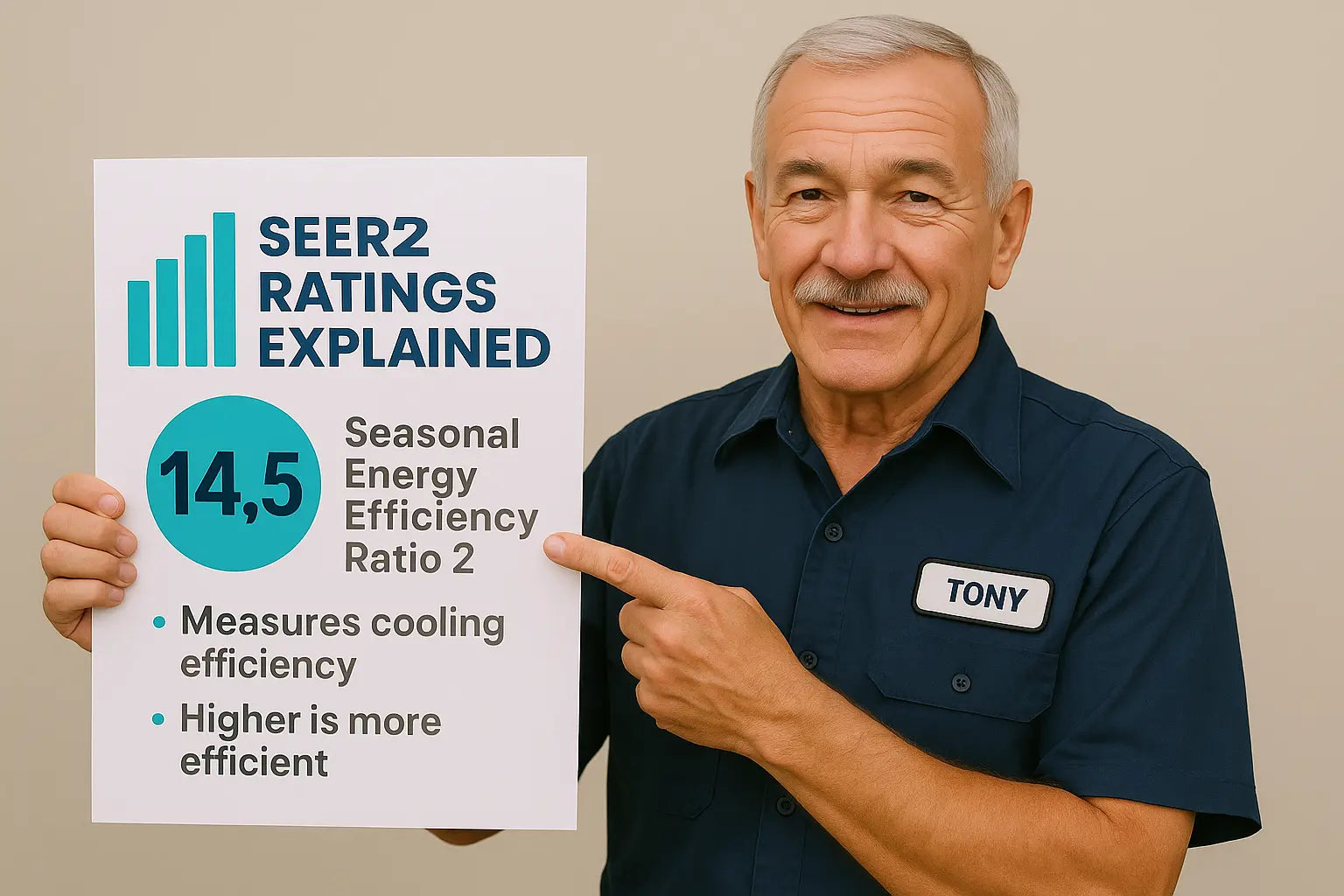Understand Energy Efficiency Before You Buy Your Next Heat Pump or AC System
🧠 Introduction: Why SEER2 Matters Now More Than Ever
If you’ve shopped for a new heat pump or central air conditioner lately, you've probably come across terms like SEER2, EER2, and 14.5 efficiency ratings. But what do they mean—and why should you care?
As your go-to HVAC pro, Tony is here to break it all down:
-
What SEER2 actually measures
-
How it compares to older SEER ratings
-
What makes 14.5 SEER2 a smart efficiency sweet spot
-
And whether it’s worth spending more for higher ratings
Let’s cut through the jargon and make sense of this critical number.
📐 What Is SEER2? A Quick Refresher
SEER2 stands for Seasonal Energy Efficiency Ratio 2. It measures the cooling efficiency of your HVAC system over an entire cooling season, taking into account real-world conditions.
🧮 The Formula:
SEER2 = Total Cooling Output / Total Energy Input (watt-hours)
The higher the SEER2, the more efficiently the system converts electricity into cooling.
🔄 What Changed from SEER to SEER2?
| Old SEER (Pre-2023) | New SEER2 (Post-2023) |
|---|---|
| Ideal lab conditions | Realistic external static pressure (ESP) |
| Often overestimated savings | More accurate energy performance |
| Not federally compliant anymore | Required for all systems since Jan 2023 |
📘 AHRI Resource on SEER2 Transition
🚨 New Federal Minimums as of January 2023
| Region | Minimum SEER2 for AC (Split) | Minimum SEER2 for Heat Pumps |
|---|---|---|
| North | 13.4 | 14.3 |
| South & Southwest | 14.3 | 14.3 |
📘 ENERGY STAR Update on 2023 Requirements
If you install a system below the minimum in your region, it won’t pass inspection or qualify for rebates.
📊 What Makes 14.5 SEER2 a “Sweet Spot”?
Many homeowners wonder:
"Should I go for the minimum 14.3 SEER2—or stretch to 16, 17, or 18?"
Here’s why 14.5 SEER2 hits the ideal balance:
✅ 1. Compliance + Comfort
-
✔️ Meets or exceeds DOE regional minimums
-
✔️ Qualifies for many rebate programs
-
✔️ Suitable for homes under 2,000 sq ft in zones 3–5
💵 2. Return on Investment
-
Priced better than 16–18 SEER2 systems
-
Delivers 15–20% more savings than older SEER 10–12 units
-
Pays for itself in 3–5 years, depending on usage and rates
🔧 3. Equipment Reliability
-
Mid-efficiency units like the Goodman 2.5 Ton 14.5 SEER2 System offer:
-
Fewer moving parts than higher-SEER inverter systems
-
Less wear and tear over time
-
Easier access to parts for repairs
-
📘 DOE HVAC Energy Efficiency Primer
📉 How Much Will You Save?
Let’s say you’re upgrading from a 10 SEER to a 14.5 SEER2 system in a 1,500 sq ft home:
| System Efficiency | Est. Annual Cooling Cost |
|---|---|
| 10 SEER | $850 |
| 14.5 SEER2 | $590 |
| 18 SEER2 | $500 |
That’s ~$260/year in savings. Over 10 years, that’s $2,600+ in electricity.
📘 Use Energy Star’s HVAC Savings Calculator
🌡️ Does SEER2 Affect Heating Too?
SEER2 = Cooling efficiency only. For heat pumps, you also need to consider:
Typical Pairings:
| SEER2 | HSPF2 (Range) |
|---|---|
| 14.5 | 7.5–8.1 |
| 16 | 8.2–8.7 |
| 18+ | 9.0+ |
📘 NREL – SEER2 vs HSPF2 in Heat Pumps
If you’re in a hot climate, SEER2 is more important. In colder areas, balance it with a strong HSPF2.
💬 SEER2 in Plain English (Tony Style)
“Think of SEER2 like miles per gallon for your AC. The higher the number, the farther your cooling dollar goes. A 14.5 SEER2 system doesn’t break the bank—but still drives like a champ all summer.”
🔍 How to Find a Unit’s SEER2 Rating
Look for:
-
📑 Yellow EnergyGuide label on the unit
-
🧾 Manufacturer's spec sheet
-
📘 Certified listing on AHRI Directory
🛠️ Example: The Goodman GLZS4BA3010 Heat Pump paired with AMST30BU1300 delivers:
-
✔️ 14.5 SEER2
-
✔️ ~7.8 HSPF2
-
✔️ Suitable for homes up to 1,500 sq ft
💰 Cost Differences by Efficiency Rating
| SEER2 Rating | Typical System Cost | Installation Total | Payback Time |
|---|---|---|---|
| 14.3–14.5 | $3,000–$4,500 | $5,000–$7,000 | 3–5 years |
| 16 SEER2 | $4,200–$6,000 | $6,500–$9,000 | 5–8 years |
| 18 SEER2 | $6,000+ | $8,500+ | 8–12 years |
🏷️ Do SEER2 Systems Qualify for Rebates?
Yes! Look for ENERGY STAR certification:
-
💲 Federal tax credits (up to $600 under Section 25C)
-
💲 Local utility rebates ($200–$800)
-
💲 Energy Star partner discounts
📘 Check for local rebates here: Energy Star Rebate Finder
🧾 Things to Watch Out For
🚫 Don’t assume higher SEER2 is always better.
-
May increase upfront cost without enough savings payoff
🚫 Avoid mislabeling.
-
Some products show old SEER—not SEER2. Always verify!
🚫 Improper ductwork can destroy SEER2 performance.
-
Leaky or undersized ducts cut efficiency by 20–30%
📘 Energy Star Duct Sealing Best Practices
📌 Final Takeaway: 14.5 SEER2 Is the Smart Middle Ground
If you're looking for:
-
A reliable, affordable unit
-
With decent energy savings
-
Without the cost or complexity of ultra-high SEER2 equipment
Then 14.5 SEER2 is your Goldilocks zone—not too high, not too low, just right.
📦 Recommended System: Goodman 2.5 Ton 14.5 SEER2
✅ Best for homes 1,200–1,500 sq ft
✅ Complies with 2023+ SEER2 standards
✅ Quiet scroll compressor + durable coil design
✅ Pair with a smart thermostat for max comfort
🛒 Explore it here →
In the next article we will know about: Heat Pump vs. Furnace + AC — Which Combo Is Best for You in 2025?







